Coffever Prototype
Smart coffee brewing system for coffee enthusiasts
Overview
Coffever is a threefold ecosystem of a smart kettle and an intelligent grinder as well as a companion smartphone App. Coffever assists the coffee enthusiast uses pour-over method in brewing coffee at home. On the one hand, it helps the user control the amount of water and weight of coffee grounds - the two variables that have the most significant impact on the taste and quality of the coffee. On the other hand, it helps the user during the process of pouring water over the coffee grounds in displaying the optimal water flow speed as determined by a water flow sensor.

The Motivation
According to the National Coffee Association (NCA) report on American coffee consumption in 2017, the number of daily coffee drinkers has increased. Of all the coffee consumed daily, 59% was specialty. What it means is that more people are drinking coffee not just to get them through their day, but at a deeper understanding of its unique flavors, specific origins, brewing methods, etc.
To understand these "gourmets" and coffee itself better, we conducted preliminary research, including semi-structured interviews with coffee enthusiasts and secondary analysis from online sources. .
What we knew from our pilot study was that many coffee lovers ended up brewing coffee themselves due to their higher pursuing of quality, taste and deeper understanding of the coffee. We learned that the pour-over method is very popular because it allows for maximum manual tweaks in the process. We also discovered their passion for coffee, frustrations during the brewing process and routine to experiment and improve.

Design Process

Research
We started our formative study with recruiting participants by sending out emails, asking for “coffee lovers” that brew their coffee at home using “non-automatic” methods. We received 55 responses; the most popular brewing method was pour-over (42%), followed by French press (38%). In choosing participants, we looked for persons who indicated that they brew coffee more than 5 times a week and use brewing gears that require more manual brewing activities so that we can capture more data.
Diary Study
To learn more about how the act of brewing coffee fits in with their daily lives, the physical setup, the environment and their feelings during the brewing process, we conducted 3 diary studies and 2 in-depth interviews with home brewers.
We asked the 3 agreed participants to take photos and make annotations of their thoughts and feelings whenever they engaged in any coffee related-activities, whether it be buying, brewing, or consuming, for at least 4 days. We choose Photo-elicitation study method as it's less disruptive to concentration-heavy brewing process than other methods. At the end of the period, we conduct a post-interview with each of them based on developed protocol.
We based our two in-depth interviews on developed protocol but also probed interviewees in a more open-ended approach to explore something unexpected or exciting.
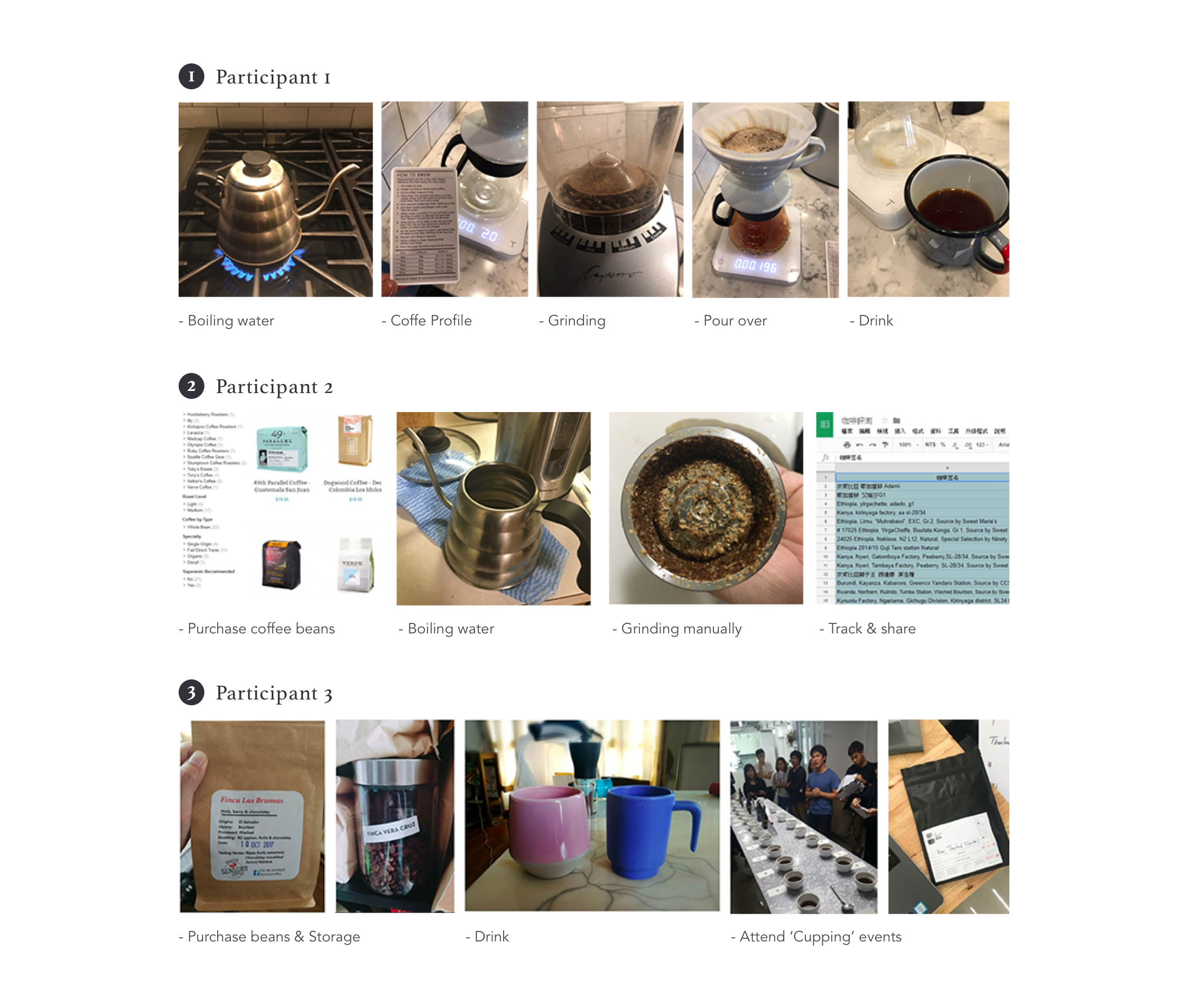
Analysis
After doing the in-depth interviews, diary study and corresponding post-interviews, we individually reflected on findings and created affinity notes. Then, we had an interpretation session of interview notes and diary study artifacts together.
The next step was to create Affinity Diagram. We read out loud the notes content which was very helpful for us to recall the location of the notes and easier for regrouping. We spent around 20 minutes on regrouping and then moved on to label each group with blue notes. Lastly, we gave them higher level categories with green notes. Based on the Affinity Wall, we had the following findings.
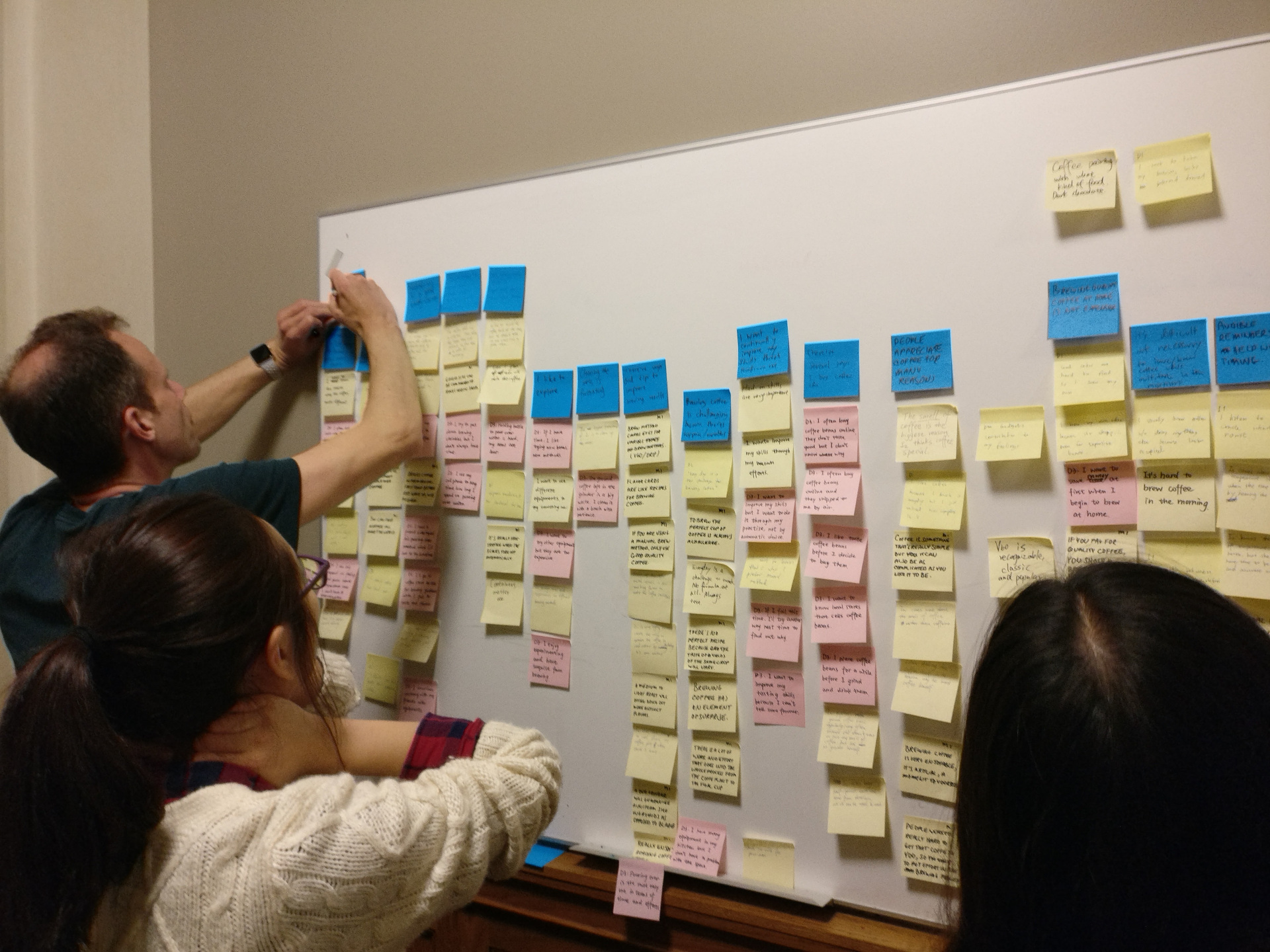
Key Findings
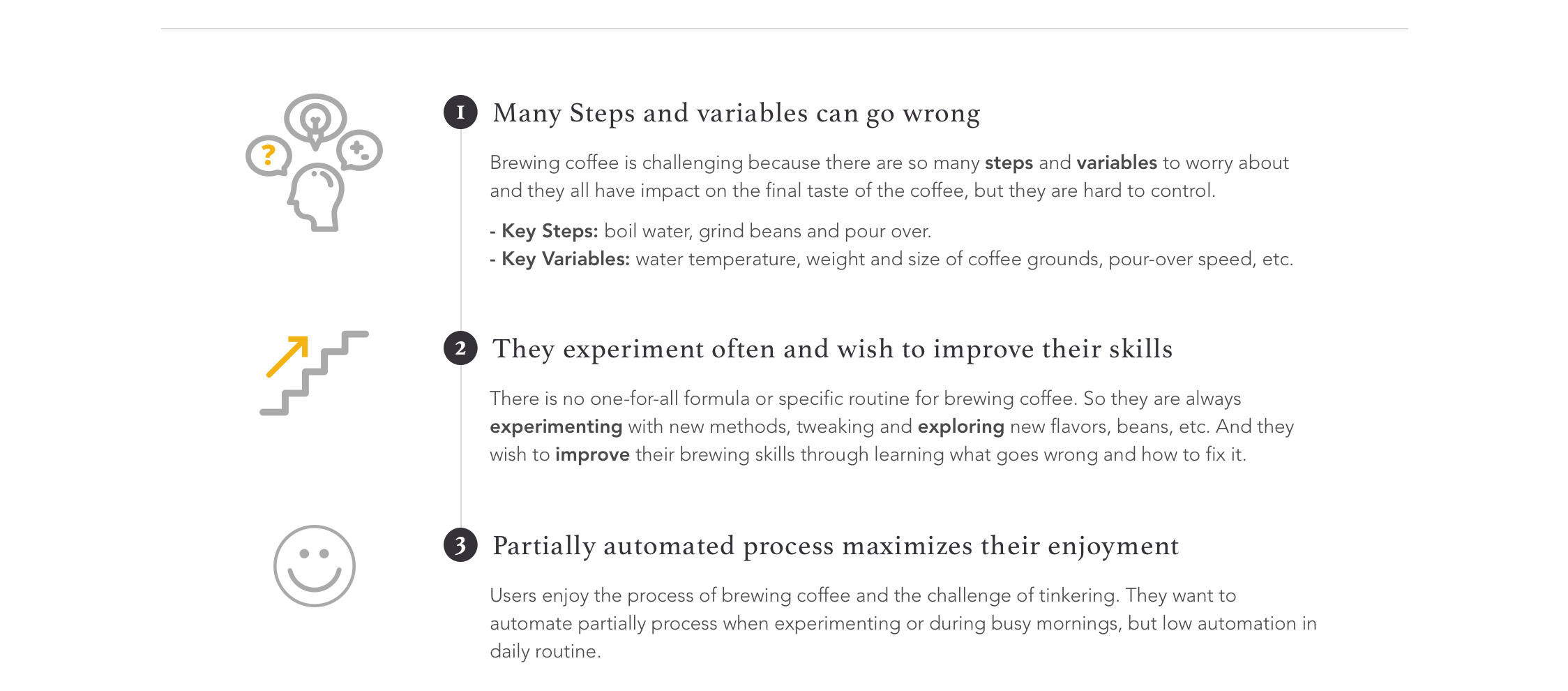
Ideation
In the ideation process, we first brainstormed and sketched individually based on our research findings. Then, we synthesized our findings and analyzed them together to share our insights. Based on the analysis, we agreed on criteria to evaluate our ideas. Next, we walked through each of our concept with sketches, had two rounds of critique.
| # | Criteria | Specifications |
|---|---|---|
| 1 | Not automate | People enjoy brewing their coffee. The design should not take this opportunity away by automating all core steps. |
| 2 | Non-intrusive | Coffee lovers already have much to think about. The design should be kept simple and does not provides more distractions. |
| 3 | Enjoyable | The design should make coffee lovers feel enjoyable about brewing coffee. |
| 4 | Not time-wasting | The elaborated manual brewing process is taking precious time in morning rush or similar scenarios. The design should not add significantly more time requirement, or, better yet, save time. |
Initially, we came up with a total of 20+ different recommendations. Then, we voted based on defined criteria and we decided the following selection of 3 "candidates."

Refined Concept
We combined the three concepts above and simplified the design components a bit to create a unified experience for later testing. All three devices listed below connect to each other via Bluetooth and exchange data with each other (from concept 3).

Smart Kettle. We decided to use a kettle spout attachment/sensor (from concept 1) which gives the user directional feedback to help them pour the water in a certain pattern. There are two variants of the design. One is an electronic kettle automatically heats up water and keeps it at the optimal temperature. A built-in valve at the tip of the spout controls water flow (speed). The other one is a Gooseneck kettle spout-attachment with sensors that measure water flow (speed), the total amount of water, and water temperature.
Smart Grinder. We also included a grinder with integrated scales to measure the weight of the grounds, as well as a pulsating grind size adjustment ring (from concept 2) to set the coarseness of the grounds. It automatically grinds beans until the grounds have reached the desired coarseness level. a Gooseneck kettle spout-attachment with sensors that measure water flow (speed), the total amount of water, and water temperature.
Smartphone APP. The smartphone app is designed to do settings beforehand and show the summary of synced variables (from concept 1 and 3) that were last used, such as the weight of coffee beans, the temperature of the water during each pour, amount of water /pour, and coarseness of coffee grounds.
Validation
To better understand how our design ideas would resonate with our target audience, we planned to conduct User Enactment studies guided by Davidoff et al.’s Speed Dating Matrix.
Speed Dating Matrix
First, we brainstormed possible dimensions for the matrix based on our previous fieldwork. We came up with the following principal dimensions and the Speed Dating Matrix:
Technology Intervention: Based on our findings, we learned that our target users see the act of brewing coffee is more of an enjoyable ritual than a chore. Therefore, they are sensitive to the visibility and disruptiveness of technology.
Modality of Feedback: Brewing coffee using the pour-over method is an activity that involves many senses (vision, hearing, and touch, etc.), and brewers have different sensual reactions toward the coffee brewing process.
Busyness Level: Even though our users prefer making coffee by themselves rather than fully automated methods, they don’t always have enough time and attention to devote to their passion. senses (vision, hearing, and touch, etc.), and brewers have different sensual reactions toward the coffee brewing process.

figure 1.Speed Dating Matrix
User Enactment Study
We created a total of 7 scenarios that correspond to the various intersections on our speed dating matrix, as shown in figure 1 above.
They are:
- Morning rush | Audio modality | High intervention (Smart Kettle)
- Morning rush | Visual modality | Low intervention
- Weekday afternoon | Audio modality | Medium intervention (Barcode)
- Weekday afternoon | Tactile modality | Medium intervention (Barcode)
- Lazy Weekend | Visual modality | High intervention
- Lazy Weekend | Visual modality | Low intervention
- Lazy Weekend | Audio modality | Medium intervention
We recruited a total of 5 participants for our User Enactment studies. And we conducted each study with at least a narrator and a note-taker. After each scenario, we would ask the participant for their feedback of how they felt after acting out a particular scene and what their thoughts and feelings were regarding the interactions.
We created our props based on our scenarios, as shown on in figure 2 on the right. We eventually built a scene sets on a kitchen countertop. Also, we also incorporated a few real artifacts used in coffee brewing process as we felt their physical properties made the UE feel more real. We used photos of a stove and a digital scale to simulate a kitchen scene.
UE Study Script

figure 2.Setup
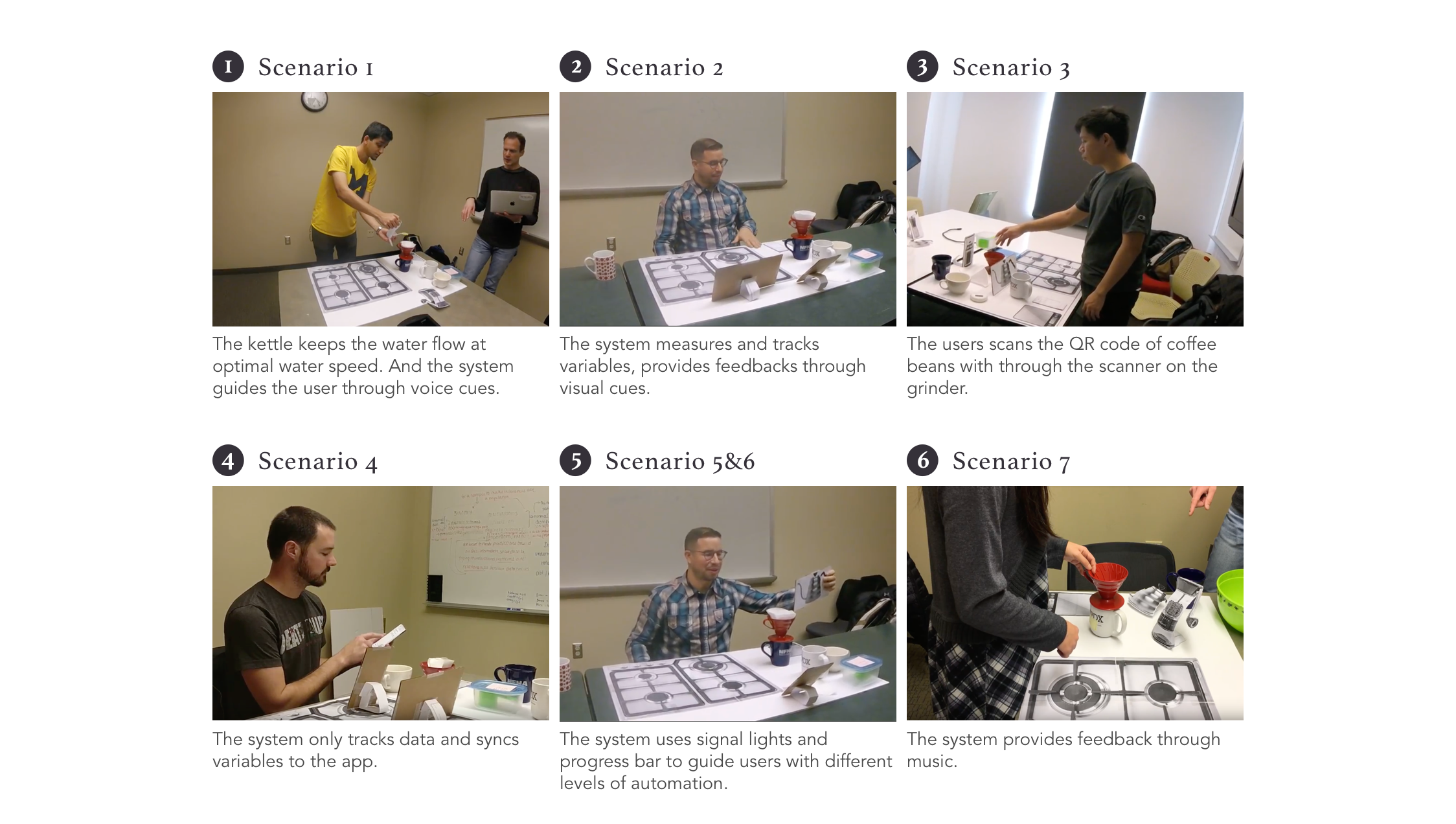
Analysis
Based on video recordings and the notes we took during the sessions, we reflected individually and gathered our findings regarding Speed Dating Matrix. We then met as a group and aggregated our findings by reading through the notes together, moving them around, and labeling and highlighting the final insights.
Insights

System Proposal
Based on the insights, we tweaked our original design of individual components and the whole process. To guide our iteration, we defined the criteria shown below and selected the most satisfying ideas to form a unified experience.
| # | Criteria | Specifications |
|---|---|---|
| 1 | Prefered by most of the users | The design should respect the preference of users. |
| 2 | Interaction must not overwhelm the users | Keep the interactive mechanism neat and not intrusive. |
| 3 | Fit in users’ brewing pattern | The design should not disobey users habit of brewing coffee. |
| 4 | Technically feasible | the design should be implementable. |
| 5 | Intuitive | The design should be self-explanatory and easy to understand. |
Final Decisions
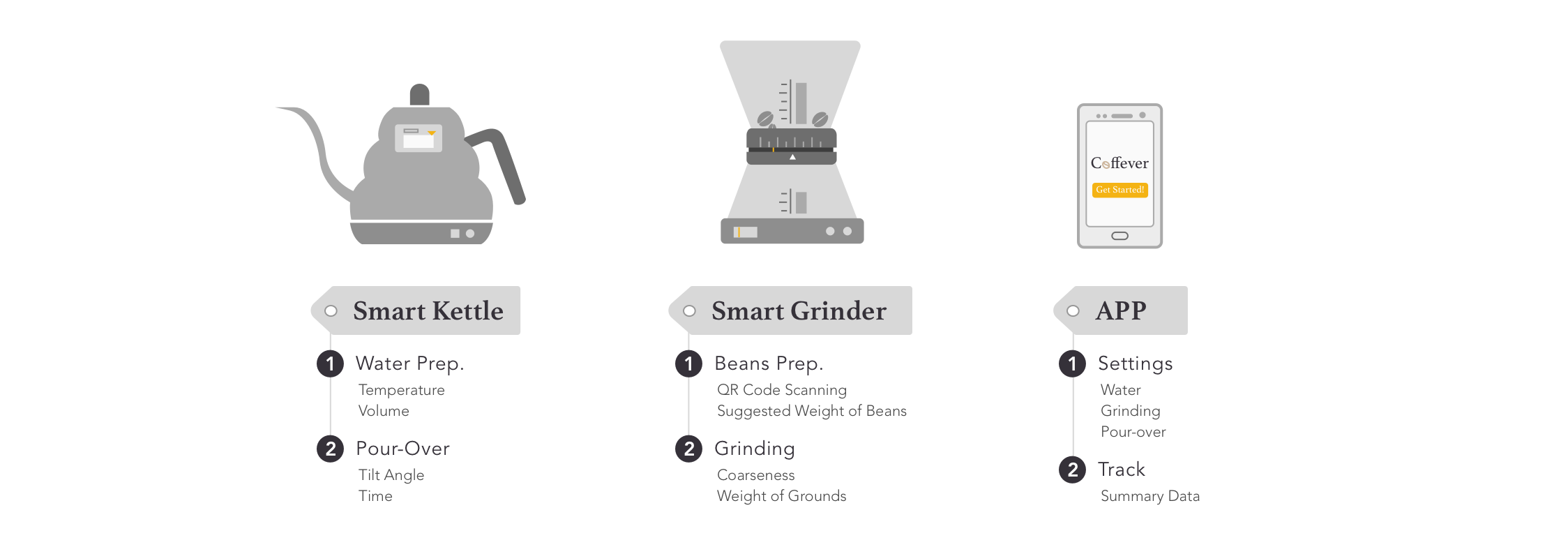
Our final brewing system - Coffever, comprises an App assistant and a smart product set that talks to each other which includes a smart grinder and kettle.
Smart Kettle: Smart Kettle is an electric kettle heats up a certain amount of water to a predefined temperature. It also guides the user to pour over by telling the user the time for each pour, the suggested tilt angle through a graph on an LCD.
Smart Grinder: Smart Grinder recognizes the type of coffee beans by scanning the QR code on the coffee pouch. Additionally, it measures the weight of the coffee grounds and grinds only the correct amount of beans. It also suggests the coarseness of the grounds on the ring according to the type of beans used.
Smartphone APP: The Smartphone App tells the user suggested properties of different variables through the other two devices. It first recognizes the type of beans via the QR code or manually entering by the user. All the data syncs with it during the brewing process which will be used to generate a daily summary for reflection.
Key Features
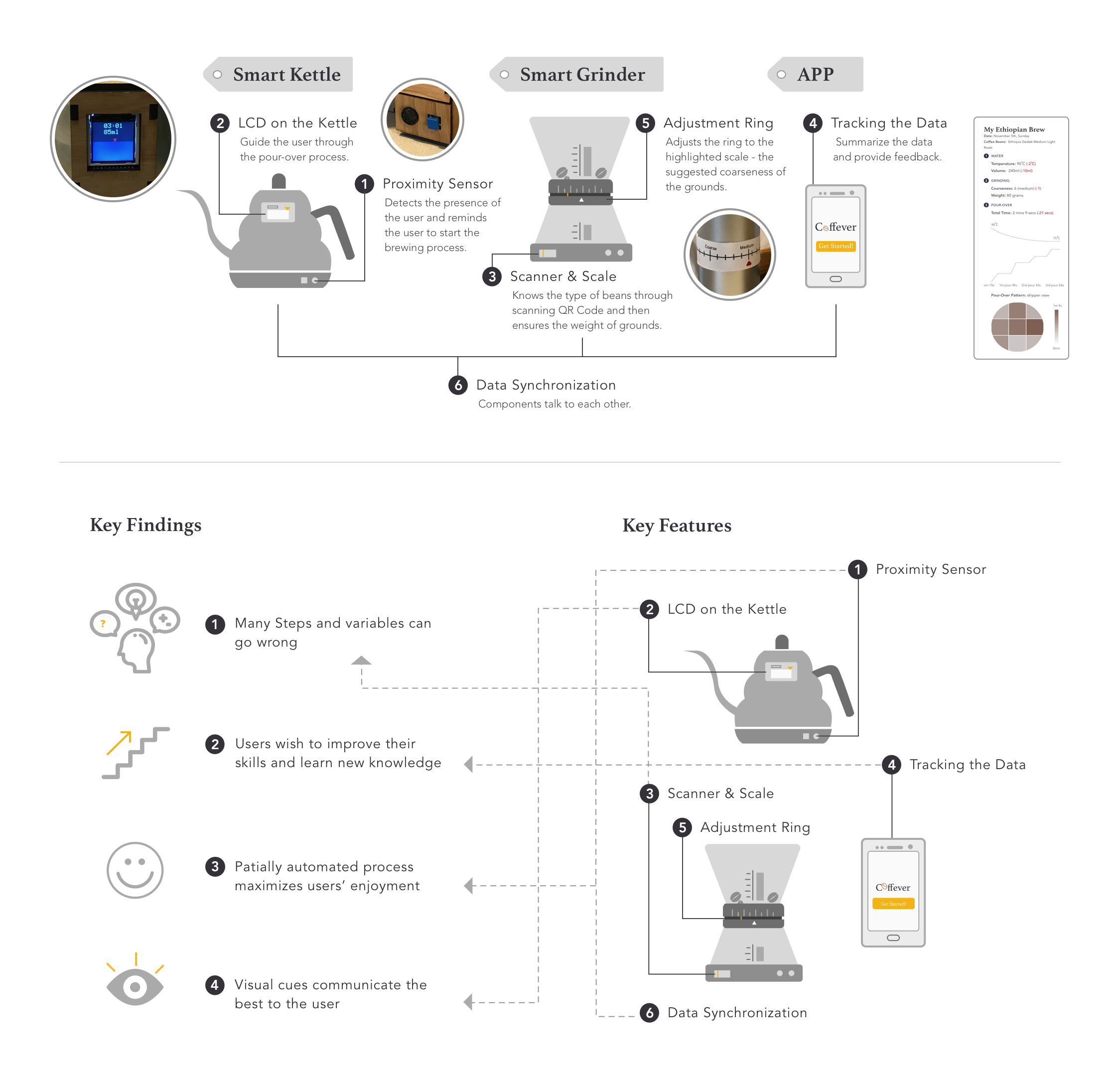
Workflow of the System
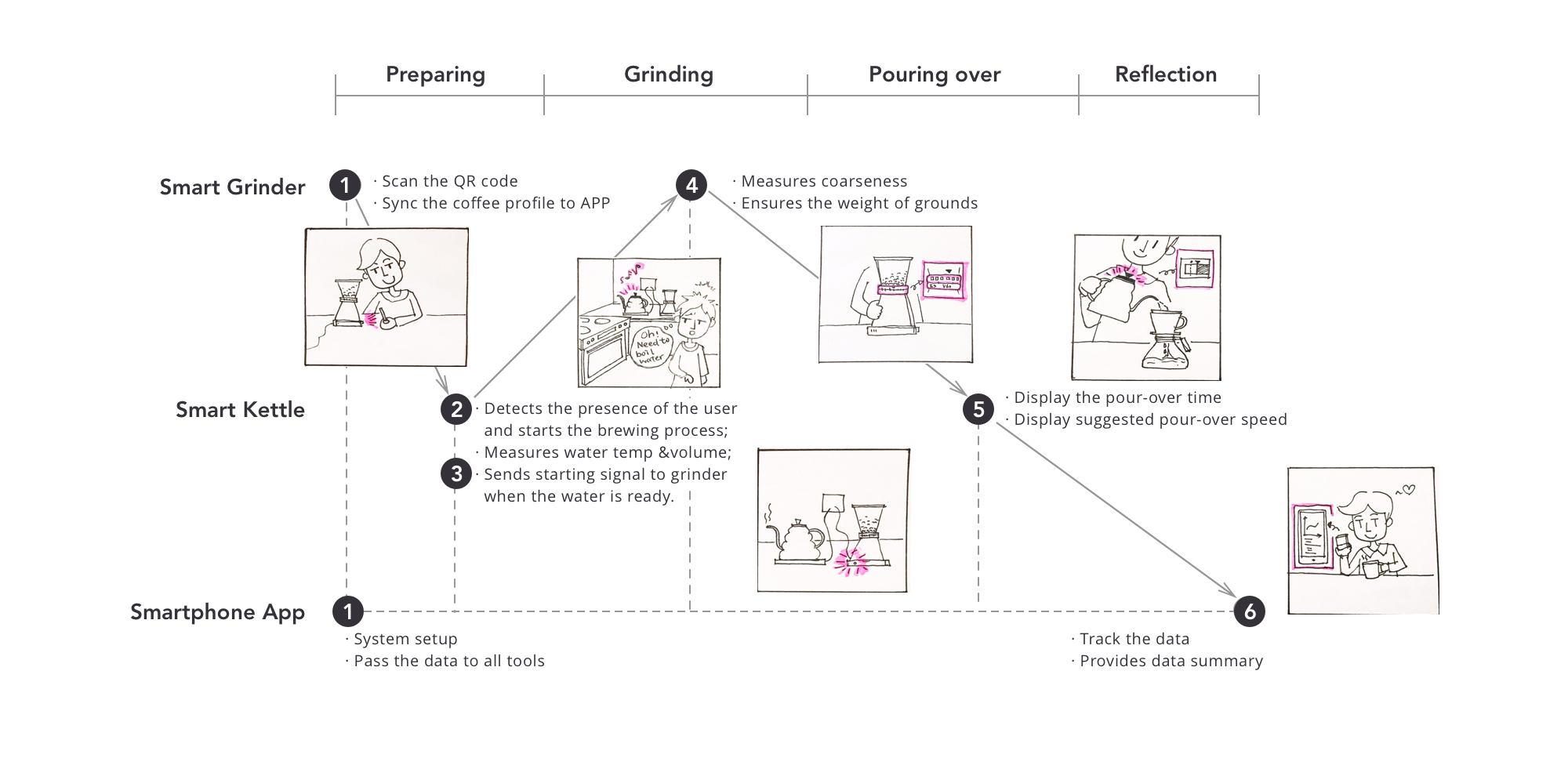
Step 1: The user enters the coffee profile by scanning the QR code on the coffee pouch via grinder and sets the wake-up time of the system via the smartphone app.
Step 2: In the next morning, he wakes up and walks into the kitchen. The system detects his presence, so the smart kettle begins to blink and chime, reminding him to boil water which he sometimes forgets.
Step 3: Since there are still coffee beans left, the grinder automatically works when the smart kettle starts to boil water.
Step 4: The user then sets up the coarseness level suggested by the grinder and pushes the button to start the grinding.
After this, he leaves the kitchen and gets ready for work. Both the water and the ground are ready when he comes back.
Step 5: He puts the coffee grounds into the dripper (with filter) and starts pouring over following the guidance of the smart kettle. He adjusts the tilt angle of the kettle by following the ascending triangle on the LCD to keep the right pouring over speed. He stops when the white bar entirely turns to blue, suggesting this pour is complete.
Step 6: Now, the user can enjoy a good cup of coffee. Meanwhile, he can check all the summary data of this brewing experience and knows what to improve for next time.
Coffever
Please check out our demo video on the left and the mobile app mockups using the link below.
Mobile App Mockups
Reflection
We found that the act of pouring over is the essential step of the brewing process, so we decided to focus our prototype on the smart kettle. However, our prototype does not measure the amount of water but the tilt angle of the kettle instead. For the next step, we propose to use a flow sensor at the tip of the kettle spout which allows for accurate measurement of the amount of water.
Due to the time constraints, we didn’t build a prototype of the smart grinder. We have to consider whether to make a grinder that weighs the grounds or if we should focus on the adjustment ring.
To validate the system, we need to conduct various usability tests to find out how the prototype resonates with users. It's also necessary to create a clickable prototype of the smartphone app to evaluate its usefulness.
